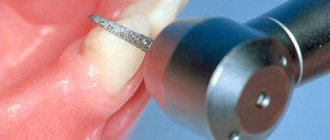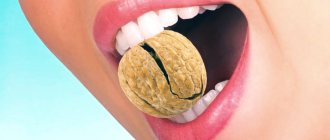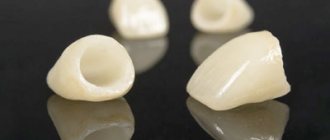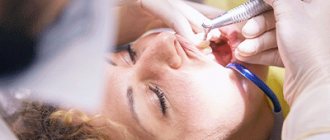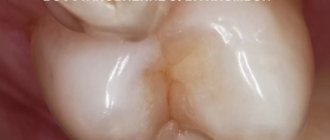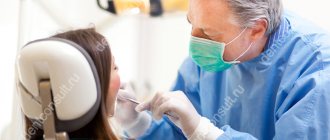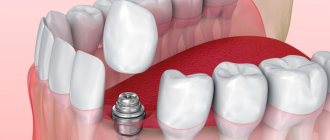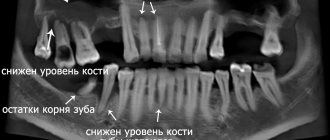- Author:
Naumovich Yulia Yakovlevna - Specialty:
Dentist-orthodontist - Category:
Doctor of the highest qualification category
Learn more about the doctor Get a consultation
A tooth fracture is a traumatic injury to the root or crown of a tooth, which may be accompanied by destruction of the socket, fracture of the alveolar process or jaw bone.
Violation of the integrity of the tooth can occur at different levels: in the coronal, middle or apical part. Adolescents often encounter fractures; by the age of 14–17, the formation of tooth roots is almost complete. Fractures of the upper incisors are most common, while injuries to the roots of the incisors on the lower jaw are rarely detected.
A fracture of the crown part of a tooth occurs: without opening and with opening of the internal cavity.
A tooth root fracture can be longitudinal, transverse, or oblique.
What is
Not everyone knows about a tooth fracture, but dentists encounter this problem quite often. Many fractures occur in children, boxers, stuntmen, and active sports enthusiasts. Another common option is accidents when a fracture is caused by accidental mechanical damage. It often occurs during an accident or fight.
As is the case with various parts of the body, a fracture negatively affects the anatomy and natural shape of the tooth.
A tooth fracture is a violation of the integrity of dental tissue (one or more of its layers) down to the tooth root. In most cases, the upper front teeth, in particular the central incisors, are affected. A fracture of the alveolar process, root or crown may also occur.
Common Causes
In addition to the factors mentioned above, it is also worth noting unqualified treatment. For example, when removing a lower jaw tooth with forceps, you can damage one of the upper teeth with the instrument. If a tooth is weakened by various diseases or is in poor condition, the likelihood of a fracture is very high. Of course, such cases are very rare, but they do happen. Another reason for a fracture is an error at the stage of selecting the size of the holes in the pins. It is important to note that the lack of treatment for caries also negatively affects the condition of the enamel, as a result of which sometimes eating solid foods can provoke a crown fracture. Do not forget about the anatomical features of the jaw. If its structure has certain defects, the pressure will be distributed incorrectly.
Causes
All reasons can be divided into two groups – dental and household. When performing dental procedures, a fracture can be caused by the doctor’s inaccurate use of forceps and elevators, or a blow to the antagonist tooth during extraction. In general, such reasons can be considered rare. Domestic injuries are much more common. It can be caused by:
- Severe mechanical shock, for example during a car accident.
- Biting on hard food. Incisors with carious cavities are especially susceptible to damage.
- Bad habits (opening caps, bending metal objects with teeth, etc.).
Teeth can break in the transverse, oblique and longitudinal directions. If the damage is severe, the cavity may open.
Diagnostics
If a tooth is fractured, you must consult a dentist. Of course, if the problem does not cause discomfort, which occurs in rare cases, there is no need to rush. But delay can cause even more serious damage, resulting in the tooth having to be removed. Fracture of the anterior elements of the dentition has an extremely negative effect on the beauty of the smile.
A specialist can easily diagnose a tooth fracture. You just need to establish the extent of the fracture and understand whether the remains of the tooth can be saved. To do this, an x-ray is taken, with which the doctor checks for displacement, damage to the root, adjacent tissues and the direction of the fracture. The specialist examines the injured area, analyzes the presence of external damage, swelling, and changes in the color of the enamel. The latter may be a sign of soft tissue necrosis or damage to the neurovascular bundle and filling of the dentinal tubules with blood.
If during percussion a person experiences painful sensations in the damaged tooth and nearby elements of the dentition, this may be a sign of injury to the periodontal and periapical tissues or tooth dislocation. Electroodontometric diagnostics may also be necessary, with which the doctor checks the viability of the pulp in the event of a serious fracture, so that in some cases it can be preserved.
Classification of dental injuries
There are acute and chronic dental injuries.
Depending on the time of occurrence, they can be permanent or temporary. Primary teeth are characterized by dislocations and, less commonly, root fractures. Permanent injuries are considered: crown fractures, tooth root damage, as well as bruises and dislocations. There are 8 known types of dental injuries:
- Tooth bruises – accompanied by violations of the integrity of the tooth structure (cracks, chips);
- Uncomplicated crown fractures;
- Complicated coronal fractures;
- Complete crown fractures;
- Fractures of crowns with violation of the integrity of the longitudinal root;
- Root fractures;
- Incomplete dislocations;
- Complete dislocations.
Regarding the completeness of the formation of the root system, the following types of dental injuries are distinguished:
- damage due to incomplete root growth;
- damage with incomplete formation of the root apex;
- damage with a fully formed root.
In addition to these injuries, there are also combined forms:
- incomplete dislocation and fracture of the crown (or root of the tooth);
- fracture of the dental crown and tooth root;
- dislocation with fracture of the root (or crown) of the tooth.
Bruised tooth
A tooth bruise is a closed mechanical injury to a tooth, in which its integrity, as a rule, is not compromised. The injury is accompanied by damage to periodontal tissue (tear or rupture of fibers). When the neurovascular bundle is completely ruptured, hemorrhage occurs into the pulp chamber and pulp necrosis.
The damage is characterized by severe aching pain, intensifying when biting or percussing the tooth. Swelling of the periodontal tissue can cause the tooth to appear as if it is coming out of its socket. Slight tooth mobility may also be felt. Hemorrhage into the pulp chamber leads to a change in the color of the tooth, which becomes pink.
Diagnosis and treatment of tooth bruises
A tooth bruise is diagnosed after taking a history and based on clinical manifestations - darkening of the crown, pain. Instrumental data are also taken into account. An X-ray reveals the widening of the periodontal fissure and the likelihood of a tooth root fracture. A patient with a tooth bruise is expected to undergo monthly electroodontodiagnosis (EDD).
The main principle of treating injury is to minimize the load on the damaged tooth until the pain completely subsides. It is recommended to refrain from eating solid foods and chewing on the large side. In order to eliminate discomfort, the doctor can grind down the sharp edges of the tooth that cut the tongue and cheek. To stop inflammation, the dentist prescribes medication and physical therapy. If the doctor determines pulp necrosis, then cleaning is carried out with further filling.
Tooth luxation
Tooth luxation is an injury in which a tooth partially or completely loses its connection with the socket. Incomplete tooth luxation (or extrusion) occurs due to tear (rupture) of periodontal fibers and due to damage to the walls of the alveoli. Such an injury is accompanied by pain, changes in the position of the tooth, its mobility, and the inability to chew. The displacement of the dental crown can be in the vestibular, distal, oral and other directions. The root of the tooth may deviate in the opposite direction. As periodontal tissues become damaged, bleeding “pockets” of teeth or gums occur. Incomplete dislocation is often accompanied by the formation of dental granulomas or root cysts, chronic periodontitis, disturbances in the formation of the tooth root, expansion of the dental canal, etc.
In case of complete dislocation (for example, traumatic extraction of a tooth), a rupture of periodontal tissues is observed with the capture of the circular ligament of the tooth, which is accompanied by its loss from the socket. The central incisors of the upper jaw are more susceptible to injury. During the examination of a patient with such a diagnosis, the tooth may no longer be in the row. In its place there will be only an empty hole with a blood clot.
Impacted tooth dislocation is accompanied by the penetration of the tooth root into the bone with the immersion of its coronal part into the cavity of the socket. With such injuries, the crown of the damaged tooth will be lower in level among others. The damage manifests itself as acute pain and alveolar bleeding.
Diagnosis and treatment of tooth dislocation
Diagnosis of tooth dislocation is made based on the clinical picture of the oral cavity and X-ray data. Studies make it clear what condition the alveolar bone is in and where the diseased tooth is located. The EDI procedure will help determine the viability of the pulp. In case of incomplete dislocation, treatment is aimed mainly at preserving the tooth. For this purpose, the dislocated tooth is returned to the socket and fixed with splints or mouthguards. A gentle regime and anti-inflammatory drugs are prescribed. Every month the patient must be observed by a dentist to monitor the process of tooth healing. If the pulp has died as a result of injury, the doctor performs endodontic treatment.
Treatment for complete dislocation involves prosthetics or dental implantation. If possible, replantation is performed and the tooth is returned to the socket, where it is fixed with splints. Impacted dislocations involve tooth repositioning under local anesthesia with further immobilization and orthodontic treatment. If the tooth cannot be restored, it is removed and replaced with a prosthesis.
Tooth fracture
The following tooth fractures are distinguished: crown part within the enamel, crown detachment or root fracture. A crown fracture is noticeable to the naked eye: it is characterized by changes in the shape of the tooth, disrupting its aesthetics, and acute pain. The tooth remains motionless. The sharp edges of the broken coronal part injure the mucous membranes of the mouth, tongue and lips. Such an injury can provoke acute traumatic pulpitis (or periodontitis).
There are longitudinal, oblique, transverse and comminuted fractures of the roots of teeth, which are localized in the middle, lower or upper third, and can also be with or without displacement of the fragments. Fractures are characterized by severe pain that increases when biting or percussing the tooth. The crown can be movable to varying degrees.
Diagnosis and treatment of tooth fracture
A tooth crown fracture is diagnosed during a dental appointment. To confirm or exclude the diagnosis, targeted radiography is done. In order to assess the viability of the pulp, EDI is prescribed.
Treatment of damage to the crown is aimed at restoring its natural shape through the use of composite materials or using a stump inlay. If there are complications with a tooth fracture, treatment of pulpitis followed by tooth restoration may be required. Treatment for a root fracture involves tooth extraction or endodontic therapy followed by placement of a post.
Signs
The most common and obvious sign of a tooth fracture is pain, which in some cases can be very severe. Pain sensations increase noticeably at the moment of closing and opening the jaw. If we are talking about a minimal fracture (the enamel is damaged, but the pulp and dentin layer are kept healthy), the pain will be less noticeable compared to a tooth root fracture.
Fractures can be complete or incomplete. During the first, the pulp is opened, as a result of which various irritants can make the pain more severe. Complete fractures are considered to be a fracture of the entire root or its apex, as well as a fracture of the neck of the tooth. In case of an incomplete fracture, damage to dentin and enamel may occur.
Additional symptoms of tooth fractures may include loosening of teeth, problems with speech, bleeding gum tissue, and difficulty opening or closing the mouth.
Symptoms
The main clinical sign is a sharp pain that occurs at the time of injury. When you try to open your mouth or touch the area of injury, this symptom intensifies. This is due to damage to the pulp and soft tissues of the oral cavity.
The second sign is bleeding. It can be of varying intensity depending on the volume and location of the damage. The injured tooth begins to become very loose, sometimes its fragments fall out of the oral cavity.
A fracture of the tooth crown is noticeable upon examination. Its integrity is more or less compromised, the adjacent gum is hyperemic, and pinpoint hemorrhages may be observed. In case of injury, the pulp is usually exposed; such cases are particularly painful due to exposure of the nerve.
Fracture of a tooth at the root.
A tooth root fracture may not be noticed at first glance. It will stagger and may deviate from its normal position. Touch or slight pressure causes sharp pain. The crown may retain its original appearance or acquire a pink tint.
There are minor fractures in the form of chips, without opening the pulp. Such injuries are less painful and allow you to restore the anatomical integrity of the tooth in the shortest possible time.
A child's baby teeth are not as strong as permanent teeth, so they break quite often. The risk factor is an active lifestyle, typical for most children.
Varieties
In addition to those mentioned above, there are the following types of fractures:
- Transverse. This is the least problematic option, especially if the pulp is not damaged. The choice of treatment method is determined taking into account the degree of the fracture. If only the crown is damaged, it can be increased. If the pulp is damaged, in most cases it must be removed, after which the tooth is restored based on the existing root. If, as a result of the fracture, only the root remains, the tooth is built up with pins.
- Longitudinal or vertical. In this case, it is impossible to restore the tooth with a pin, since the remnants of the root are not capable of serving as the basis for a crown or pin. If an element of the dentition is broken in half, it is very difficult to identify the problem. People often waste time, and the condition of the tissue quickly deteriorates, as a result of which the tooth is usually removed.
- Splintered and oblique. In such situations, the development of events occurs approximately the same as in the case of longitudinal fractures.
Causes of dental injuries
Dental injuries occur due to:
- a blow to the jaw area during an accident, fight or sports competition;
- falls;
- presence of bad habits (holding foreign objects in the mouth, chewing bones, nuts, opening lids);
- pathological thinning of the enamel, which leads to tooth destruction;
- violation of treatment technique by an insufficiently qualified dentist;
- incorrectly sized intracanal pin;
- improper removal of an adjacent tooth using an elevator;
- an incorrectly selected filling or its incorrect installation by an orthodontic device;
As a complication of dangerous dental diseases: enamel hypoplasia, cervical caries, tooth root cysts, fluorosis or even jaw tumors.
STOMATITIS FLUX
Crown fracture
This is one of the types of transverse fractures, it is quite easy to identify. The choice of treatment depends on the size of the chipped segment and the condition of the pulp. If the dentin is not damaged, but only part of the enamel is affected, a composite filling is the solution. In case of a fracture of the front tooth, extensions or veneers can be used.
If dentin is affected, doctors use special insulating pads. In cases where a tooth breaks in half and the pulp is damaged, it is removed and the canal is filled. Next, a pin can be installed followed by the use of a filling composite in order to restore the original shape.
A fracture of the neck of the tooth is also common. There are cases when the tooth wall breaks completely, but the pulp sac is not damaged. Typically, in such situations, specialists are in no hurry to get rid of the root, since it can become a good basis for a pin. In this case, in any case, the pulp is removed.
Symptoms
In addition to these manifestations, the symptoms of a partial or complete fracture are of a similar nature. The location of the chip can be easily visualized or felt during a tactile inspection. Contact is accompanied by painful attacks, the severity of which depends on the relationship between the position of the damaged area and the pulp. The closer the chip is to the inner chamber, which contains nerve endings and blood vessels, the more sensitive the reaction to any external stimuli.
When a tooth is fractured, pain also occurs due to changes in the acid-base balance of the oral cavity, inhalation of hot or cold air, and when eating food at different temperatures. Damaged elements are characterized by mobility relative to adjacent units, which indicates a violation of the structure of the ligaments that hold the element in the alveolar socket.
Diagnosis and treatment
Diagnosis of a pathological condition in a clinical setting is carried out using methods of visual inspection, palpation and percussion, as well as hardware examination, which includes EDI, radiography and transillumination. The choice of treatment method, as well as the decision to extract an element, is based on the clinical picture. In cases where the tooth remains viable, the following restoration methods are used:
- Splinting is the fixation of teeth using a mechanical structure, recommended for fractures of the first degree of severity.
- Replantation is a specific procedure in which a broken fragment is re-placed in its original position.
- Restoration - filling with composite materials, possible provided that the defect does not affect the internal cavities.
If a fracture occurs that affects the pulp, then the procedure of trephination and removal of the pulp is performed. The canals are sealed, and the fragments are fastened with pins. When a diagnosis is made of the non-viability of the pulp structure, the problematic unit is subjected to extraction and replaced with a prosthesis or implant.
Root fracture
In the event of a tooth root fracture, a specialist analyzes its position to select the appropriate treatment. The fracture can occur near the neck, at the apex, in the middle part, or at the border of the upper and middle parts. In most cases, transverse fractures occur.
Diagnosis of such damage does not cause any difficulties. First of all, a person feels pain while chewing food and biting it. During palpation, mobility of the injured element of the dentition is observed. When percussing and closing the jaw, the patient experiences discomfort and pain. And if the fracture is located near the crown, the enamel may take on a pink tint. Radiography helps to clearly establish the number of cracks, as well as their position.
Causes of tooth fracture
There are chronic and acute (sudden) causes. This division is necessary, since the treatment regimen depends on the type of injury. The causes of the acute form include any mechanical impact on the dentition. It could be:
- severe blow as a result of a fall, fight or accident (injury to the lower part of the face);
- dentist errors during tooth extraction or treatment;
- biting hard objects, such as seeds in fruit;
- attempts to open or bite through an inedible object with the teeth.
Chronic traumatic factors include long-term human illnesses:
- advanced caries;
- vitamin deficiency, namely calcium deficiency;
- pulpitis;
- softening of dentin as a result of necrosis of hard tooth tissues;
- abnormalities in the structure of the jaws;
- presence of a cyst;
- enamel hypoplasia.
Regardless of the cause, traumatic tooth damage requires consultation with a dentist. This will save the tooth and avoid complications.
Treatment options
First of all, patients are prescribed an odontometric and x-ray examination. The information obtained helps determine the degree of fracture, the presence or absence of fragments, the condition of the pulp, as well as the number of fractures and their direction. If there is minimal damage, for example, a fracture of a front tooth with a small chip, its natural shape is restored using appropriate composite materials.
If oblique, comminuted or vertical fractures are found, in most cases the tooth must be removed, since its root is not capable of becoming a full-fledged basis for restoration with a pin. Usually the problem is solved by tooth extraction and further use of implantation.
If a tooth is broken at the root, it can also be restored. Otherwise, a metal-ceramic crown is used, the appearance of which is completely identical to the shape and color of the natural tooth.
If the pulp is damaged, it is usually removed. Then the canal is filled and the tooth is restored using a filling. But you must also make sure that its shape looks natural. Otherwise, closing the jaw may cause subsequent damage to the restored tooth. Another possible problem is the formation of an incorrect bite.
If a dead tooth is fractured at the root, implantation is used or a crown is installed. When a wisdom tooth is fractured, specialists usually remove them immediately. Limited access to these teeth makes them extremely difficult to fully restore.
Treatment
Treatment methods are selected based on diagnosis. The easiest way to diagnose a coronal fracture. In all other cases, an x-ray is required. X-ray examination is especially important for root trauma, since its symptoms resemble a dislocation, and when using only palpation there is a high risk of making a mistake. X-ray allows you to most accurately determine the location of the damage, the number of cracks, and the presence of displacement of debris.
Assessment of pulp viability in some cases can be carried out visually. A damaged tooth with “dead” pulp changes its color. A completely non-viable pulp gives the crown a grayish tint. With partial preservation of vitality, hemorrhage is possible, as a result of which the enamel of the injured tooth becomes white and pink. Visual inspection provides only primary data; accurate information about the condition of the pulp is obtained using hardware methods.
If you have a problem similar to that described in this article, be sure to contact our specialists. Don't diagnose yourself!
Why you should call us now:
- We will answer all your questions in 3 minutes
- Free consultation
- The average work experience of doctors is 12 years
- Convenient location of clinics
Single contact phone number: +7
Make an appointment
After assessing the complexity of the fracture, the doctor determines the degree of probability of fusion of the fragments and selects the most effective treatment methods. In some cases, attempts to restore the integrity of the tooth may only lead to a temporary improvement in the condition. In case of such injuries, it is more advisable to completely remove the tooth and perform prosthetics.
- For a coronal fracture, treatment is aimed at restoring the integrity of the crown. Depending on the degree of damage, the tooth can be built up, veneers or an artificial crown installed.
- Treatment of crown-root and root fractures is selected depending on the viability of the pulp and the degree of probability of fusion of fragments.
The most difficult is considered to be a transverse root fracture near the neck of the tooth. In this case, it is extremely difficult to restore integrity even if the pulp remains viable. In case of such injuries, the pulp is extirpated, a pin is inserted and fixed with cement. In some cases, this method can achieve a positive effect, but it will be temporary.
It is more effective to remove part of the root and restore the tooth with a pin insert. In case of comminuted fractures, the tooth is removed, since it is almost impossible to compare the fragments and place them in the correct position.
Sources:
- Personal experience as a dentist-implantologist;
- Bernardsky Yu.I., Fundamentals of maxillofacial surgery and surgical dentistry./ Yu.I. Bernardsky - M.: Medical Literature, 2009;
- Bazhanov N.N. Dentistry./ N.N. Bazhanov - M.: Nauka, 1990;
- Ordanishvili A.K., Tolmachev I.A., Tolmachev S.I. Method for identifying defects in medical care after tooth extraction surgery // Collection of inventions and rationalization. proposals. Issue 37. / A.K. Ordanishvili, I.A. Tolmachev, S.I. Tolmachev - SP b.: Neva, 2006;
- Walmsley A. Damien, Trevor F. Walsh, Adrian C. Shortall, Philip J. Lumley. Restorative Dentistry. - Edinburgh, London, New York: Churchill Livingstone, 2002;
- Robustova T.G. Surgical dentistry / T.G. Robustova - M.: Progress, 2003);
- Timofeev A.A. Guide to maxillofacial surgery and surgical dentistry / A.A. Timofeev - M.: Unity, 2004.).
Alveolar ridge fractures
The appearance of such fractures occurs as a result of a direct blow, which affects several adjacent teeth at once. Since the upper jaw is in front, it is the one that suffers in most cases. This fracture can be determined by painful palpation, as well as the presence of damage to the mucous membranes. The process begins to move, and elements of the dentition may be broken or dislocated. Part of the jaw may be torn out or supported only by soft tissues.
Such a significant jaw injury is usually accompanied by dizziness, severe headaches, traumatic brain injury, and nausea. Using an x-ray, you can determine the location and direction of damage, as well as determine whether the broken part can be repaired. If it is viable, the specialist installs a splint that provides fixation of the bone for full fusion. In case of serious injuries, teeth that cannot be restored are removed, followed by fixation of the alveolar process.
If the injury is irreversible, the broken part is removed, since in the event of a rupture of the periosteum and adjacent soft tissues, the process usually cannot take root. In such situations, the damaged area is covered by the periosteum.
Damage classification
Basic differentiation used in dentistry divides possible damage into two categories - complete and incomplete, using the degree of pulp exposure as the main criterion. Another type of classification uses the following definitions of defects:
- Chip of enamel coating.
- Dentin fracture without opening the pulp chamber.
- Dentin fracture with pulp exposure.
The condition of the pulp is assessed visually, as part of a routine examination, or independently - during hygienic oral care. Characteristic signs of the presence of damage are considered to be problems with full disclosure, local hemorrhages in the mucous tissues, sharp painful sensations that occur both at the time of deformation and during temperature changes associated with eating.
Tooth extraction after a fracture
It is necessary to remove a tooth only if it cannot be restored. If, after a fracture, an element of the dentition becomes loose, it is necessary to seek the help of a specialist as quickly as possible.
Tooth extraction is performed under anesthesia. Thanks to this, a person can completely relax and also get rid of pain. Usually everything happens very quickly, but in complex cases when a serious fracture has occurred, difficulties may arise. Sometimes the specialist has to cut the gum and pull out the remaining parts of the root, after which sutures are placed in this place. After some time they are removed. Depending on the specifics of a particular case, a specialist may recommend physical therapy and the installation of a dental implant.

